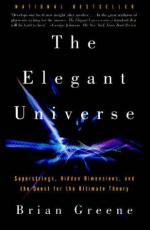
|
| Name: _________________________ | Period: ___________________ |
This quiz consists of 5 multiple choice and 5 short answer questions through Chapter Twelve, Beyond Strings, In Search of M-Theory.
Multiple Choice Questions
1. How does the number of extra "curled up" dimensions affect the vibration of strings?
(a) More dimensions allow for string with length in more than one direction.
(b) More dimensions require more energy for the same vibrational pattern.
(c) More dimensions provide more ways to vibrate.
(d) String vibration is not affected by additional dimensions.
2. At what scale of length is quantum geometry necessitated?
(a) Cosmological scales.
(b) Nanometers.
(c) The Riemann scale.
(d) The Planck length.
3. What distinction does dark matter have?
(a) It exists in curled-up dimensions.
(b) It is composed of anti-matter.
(c) It does not give off light.
(d) It can spontaneously form black holes.
4. Which of the following is true regarding our current knowledge of the Calabi-Yau space?
(a) Its shape is completely known and defined.
(b) Its shape is totally unknown.
(c) Its shape is not fully known.
(d) Physicists and mathematicians disagree about its shape.
5. How many total dimensions are required by string theory?
(a) Ten.
(b) Seven.
(c) Five.
(d) Eight.
Short Answer Questions
1. What is the importance of the string-coupling constant?
2. How does the shape of the extra "curled up" dimensions affect the vibration of strings?
3. By what factor is the minimum mass of a wrapped string in determined?
4. What is a virtual string pair?
5. In M-theory, what is a two-dimensional oscillating object is called?
|
This section contains 355 words (approx. 2 pages at 300 words per page) |

|




